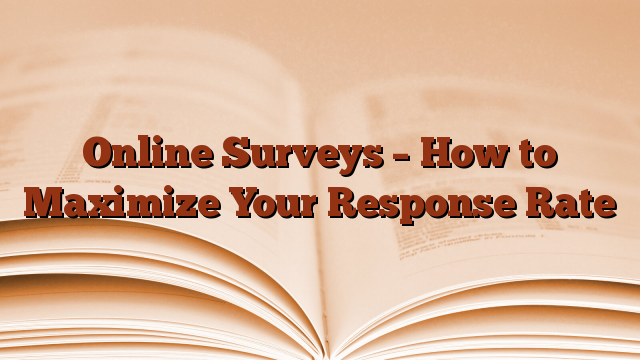Online surveys are undoubtedly the most cost-effective way to collect important data such as customer satisfaction and employee opinions. But how do you maximize your response rate? This is a problem faced by most companies that conduct online surveys and there is much literature on the subject, all with varying facts and figures in relation to the response rate that can be expected, techniques to increase the response rate, the length of the survey etc.
The simple truth is that there isn’t a single guideline to follow when conducting an online survey, as each survey has its own set of variables that affect the response rate. However, there are some common techniques used to increase the likelihood that a potential survey taker will complete your questionnaire.
After conducting hundreds of online surveys of customers, employees, companies, membership groups, and event guests, I began tracking survey response rates and the types of key variables likely to impact them. The variables recorded were:
- Whether survey invitations were personalized (i.e. Dear John Smith vs. Dear Customer)
- Survey length (categorized into 1-4 minute, 5-9 minute, and 10+ minute completion times)
- When a reward/prize has been offered
- Whether or not the survey was sent to people with a known interest in the survey topic (e.g., job-related, previous client, connected to social interests, etc.)
The figures below were derived from data from 143 online surveys completed by a total of 49,335 respondents. In general, potential respondents were contacted twice by email to encourage participation in the online surveys.
Please note that the majority of respondents had submitted their data to various databases or were customers of my customers; Therefore, it is likely that they knew the brand/company before receiving the online survey invitation. People who send email invitations to random subsets of contacts shouldn’t expect to get response rates as high as those listed below.
Considering the 4 variables and their options, there were 24 possible combinations – this makes sense when you look at the points below. The combinations with the 5 highest and 5 lowest response rates were listed.
5 highest response rates
- Personalized email & 1-4 minutes to complete & Reward offered & Respondents had a known interest in the survey topic = 45.3% average response rate
- Personalized email & 5-9 minutes to fill out & Reward offered & Respondents had a known interest in the survey topic = 40.1% average response rate
- Non-personalized email & 1-4 minutes to complete & Reward offered & Respondents had a known interest in the survey topic = 39.8% average response rate
- Personalized email & 1-4 minutes to complete & no reward offered & respondents had a known interest in the survey topic = 39.2% average response rate
- Personalized email & 5-9 minutes to complete & no reward offered & respondents had a known interest in the survey topic = 38.4% average response rate
5 lowest response rates
- Non-personalized email & 10+ minutes to fill out & no bonus offered & respondents had no known interest in survey topic = 8.2% average response rate
- Non-personalized email & 10+ minutes to fill out & reward offered & respondents had no known interest in survey topic = 15.5% average response rate
- Personalized email & 10+ minutes to fill out & no bonus offered & respondents had no known interest in survey topic = 16.2% average response rate
- Non-personalized email & 5-9 minutes to complete & no bonus offered & respondents had no known interest in survey topic = 19.4% average response rate
- Non-personalized email & 10+ minutes to fill out & no reward offered & respondents had a known interest in the survey topic = 19.5% average response rate
So what works best?
The results above show some clear correlations between response rates and the variables influencing them. As a general rule, the following measures should ensure that you get the highest possible response rate when conducting an online survey:
- Personalize your email invitations. People are more likely to respond to emails that address them by their name rather than “Dear Sir or Madam,” “Dear Colleague,” or “Dear Customer.” If you have the names of potential survey takers, use them! This is easily done with a simple software like Microsoft Word in a mail merge format sent through your Outlook account. It links directly to your database, so you don’t have to enter every single name in every email invitation.
- Keep the survey as short as possible. In most cases, the shorter the survey, the higher the response rate. Obviously, some online surveys need to be lengthy and cannot avoid 10+ minutes in length; However, try to avoid questions that only collect irrelevant information. This is a common crime among survey developers when preparing questions for an online survey.
- Offer a reward. Everyone loves getting something for free, so try offering a reward when sending out online survey invites. Some experts like Kurt Knapton, executive vice president of e-Rewards Market Research, suggest that you’re more likely to get a higher response rate if you offer each respondent a small reward, rather than a chance to win a big sweepstakes prize. His study found that asking 4,000 people to offer $2 each to take a survey garnered a 19.3% response rate. Offering the same number of people to enter a $2,500 sweepstakes draw only achieved a 12.2% response rate.
- Find contacts who are likely to be interested in the survey topic. This isn’t a scientific discovery, but response rates will always be higher if the potential respondent has some interest in the survey topic. Job satisfaction surveys always get high response rates because employees believe their answers will influence positive change. Likewise, repeat buyers of a particular product/service will no doubt be more interested in a related online survey than someone who has used it only once or never.
Thanks to Ewan McKenzie | #Online #Surveys #Maximize #Response #Rate

Leave a Reply